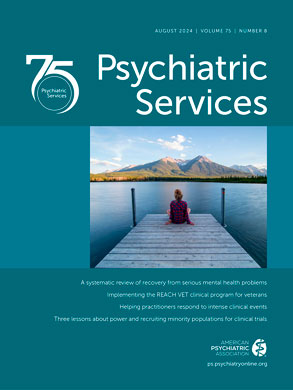To the Editor: As multidisciplinary clinicians concerned with the status of adolescent health care, we decided to examine the current state of psychosocial health care for adolescents in our nine-county area of Michigan. Primary care physicians are increasingly being asked to manage psychosocial problems in their offices, but they may not know what to screen for or may be uncomfortable asking questions that could open a Pandora's box. We needed to learn if physicians in our community addressed psychosocial issues in assessing adolescent patients.
Health supervision guidelines for adolescents uniformly recommend that the health care providers conduct a thorough psychosocial assessment during health supervision or “well-adolescent”visits (
1–
4). We focused on three issues: whether primary care physicians in a given community typically treat a representative sample of adolescents in the community as reflected by age, gender, race, and county of residence; what type of assessments they conduct during office visits—medical, psychosocial, or both; and the reason for the adolescent's office visit.
Surveys were distributed in a single mailing to 662 primary care physicians listed in the 33rd edition of the Directory of Physicians in the United States who were practicing in a nine-county area in southwestern Michigan. We designed an anonymous survey instrument to collect demographic data about the physicians and their adolescent patients. It consisted of ten fixed-choice items focused on demographic data on physicians and their adolescent patients and several Likert scales that addressed presenting problems and triggers for psychosocial assessments.
Responses were received from 106 of the 662 physicians, a disappointing low response rate of 16 percent. However, we did discover that these physicians were seeing a representative sample of adolescents. Thirty-six percent performed psychosocial assessments during routine office visits. Fifty-seven percent interviewed adolescents and parents together, 44 percent interviewed the adolescent only, and 19 interviewed the parent alone. Twenty-three percent collected information from schools. Only 4 percent used a formal psychosocial assessment instrument.
More than half of the respondents conducted psychosocial assessments when problems were identified relating to school, family, or the adolescent's personal life. They also did such assessments when they found depressive symptoms or chronic illness or when psychological problems were reported by the parents.
Although the response to our survey was less than enthusiastic, the findings lend important insights into prevailing practices of the physicians who care for adolescents in a given geographical area. It may be unrealistic to expect that most adolescents will receive a psychosocial assessment during routine “well-adolescent”check-ups, given our finding that the most frequent reasons adolescents see a physician are for acute care and camp physicals. Nevertheless, we think it is important to develop ways to integrate a psychosocial assessment into every physician contact with a patient. Determining if primary care physicians screen for psychosocial problems, when they screen, and who they serve will facilitate multidisciplinary efforts to provide training and resources to improve their ability to identify at-risk adolescents in a more effective and efficient manner.

